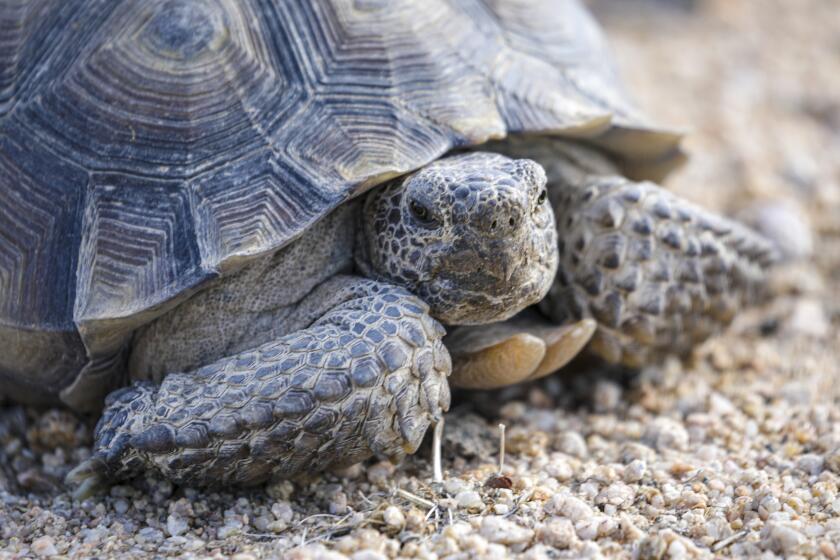No Mickey Mouse Problem : Rodents: Mice have joined real estate prices and ocean views as hot topics on the peninsula. They’re everywhere--and in large numbers.
Like a lot of homes in the area this year, the large, almost palatial house overlooking the ocean in Palos Verdes Estates has a little problem.
The house is infested with vermin, in this case mice, or Mus musculus in scientific parlance. Driven from their usual outside haunts by recent brush fires and construction projects, and with their numbers swollen by plentiful food sources, a decrease in predators and breeding habits that would make a rabbit blush, the little rodents are taking up residence in homes throughout the peninsula.
And they are spreading terror and consternation among the human residents.
The home in Palos Verdes Estates, for example, is infested with dozens of field mice; some other homes reportedly have been invaded by hundreds. It’s the worst rodent infestation residents have seen in years.
“I’ve lived here for five years and I’ve never seen it like this,” said the homeowner, who declined to be identified. “I’ve killed 15 of them myself. They got into my attic and into my fall boxes and ate all my corn decorations. One day I opened my trash compactor and one of them came running up the side. I screamed so loud, it probably scared the mouse to death.”
“It’s been a real hassle,” added Jan Gordon of Rolling Hills Estates. Gordon said her family heard the scurrying of mice feet at night and found droppings in the morning. There were several face-to-face encounters, and her overfed cat, Fluffy, was no help at all.
“Fluffy could care less,” Gordon said.
Gordon tried trapping the mice herself, to no avail. Finally, she called in professional help.
Although the mice infestation is alarming for some, it is good news for others.
“The phones are ringing off the hook,” said Stan Sanders, service manager for Terminix extermination company in Gardena, which serves the South Bay area. “We’re getting 20 or 30 calls a day (from the Palos Verdes area). The mice are driving people crazy out there.”
“It’s extremely heavy this year,” added Paul Trammell, branch manager for Western Exterminator Co. in Long Beach, which has been getting up to 10 calls a day from peninsula residents. “We don’t know exactly why. It’s probably a combination of factors, such as the recent fires, the weather, construction projects. They all tend to drive mice into homes.”
Western Exterminators charges an average of $125 to rid a home of rodents, plus extra to “rodent-proof” the home against further infestation--that is, sealing exterior cracks, crevices, holes and other points of entry.
“Rodent-proofing is 99% of the game,” Trammell said.
To Andy Zuniga, a supervisor with Western Exterminators, mice aren’t just a job, they’re an adventure.
“I love doing mice work,” Zuniga said as he stood in the large home in Palos Verdes Estates, his yellow and green uniform smartly pressed, his dark eyes steely with determination, his arms loaded with the armaments of his trade--mouse traps and a jar of “creamy style” peanut butter.
“It’s a challenge, trying to outsmart them. You can really get into it.”
For this particular job Zuniga, 39, who has been in the extermination business for two decades, will place about two dozen “glue boards” at strategic locations throughout the house--attic, garage, and near water sources such as sinks. Glue boards are plastic trays filled with a sticky substance and baited with a dab of peanut butter. Mice, like rats, are crazy about peanut butter. When the unwary mouse dashes onto the tray to snag the peanut butter, it becomes mired in the sticky goo.
The goo is not poison, however; Zuniga and other exterminators don’t use poisons in residences, partly because of the danger to pets or children, but mostly because a poisoned mouse usually will die inside a wall or other small, unreachable crevice. There it will rot, with predictably odorous consequences.
A mouse trapped on a glue board will simply struggle until it tires and its little nose falls into the goo, suffocating it. This distresses some people.
“We’ve had cases where mice have actually chewed their own legs off to get away,” Zuniga said. He added, “We mark those down as a kill.”
For that reason, and the fact that a glue-boarded mouse sometimes will go “Eeek! Eeek! Eeek!” for a considerable length of time, Zuniga said some people prefer conventional spring traps, the kind that whack the mouse over the neck. Still other people, he said, don’t want them killed at all.
“People are overly sentimental about mice sometimes,” Zuniga said. “They want you to catch them and just take them outside. I have to explain that it doesn’t work like that.”
“I have one (mouse stuck on a glue board) in my kitchen right now,” said a distressed woman in Palos Verdes Estates, where Zuniga had placed a trap. “It’s dying right now. (Zuniga) told me not to look at it, but it’s hard not to.”
After placing the glue-boards, Zuniga makes a follow-up call the next day to empty them of dead or moribund mice. The mice go into a plastic bag and are taken back to the company’s branch headquarters.
If there are only a few, the carcasses go into a trash container; if there are more than a couple of dozen--recently the company’s been handling up to 400 mouse carcasses a week from the peninsula area--they are taken to an animal control center for incineration.
Once a home has been cleared of mice and rodent-proofed, Zuniga said, the problem goes away--at least until the next time natural conditions create a large mouse population and people grow lax about conditions that lead to mouse infestation.
When that happens, Zuniga will be ready.
“Yeah, I enjoy the work,” Zuniga said. “I just hope there’s not a mouse heaven. If there is, I’ll be on the Mouse 10 Most Wanted List.”
All About Mice
* Adult mice generally weigh between 2/5 and 4/5 ounces.
* Female mice have litters of five or six within three weeks after mating; the newborn mice will be sexually mature within 10 weeks. A female may have five to 10 litters a year. Two mice can multiply to 100 mice in four months.
* Mice can hear twice as well as humans and can sense motion up to 50 feet away.
* Mice can survive a 50-foot fall (four or five stories) without injury. Mice can swim up to half a mile and have been known to tread water for up to three days. They can sometimes survive being flushed down a toilet.
* A mouse can squeeze through a quarter-inch crack or a hole the size of a dime.
Sources: Terminix and Western exterminating companies





